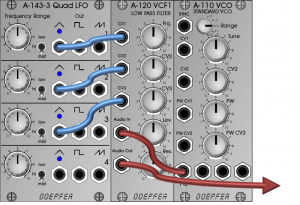The A-120 module is – the name “Low Pass 1” suggests it – something like the “mother of all Doepfer filters” (from a historical perspective, not from a technical perspective). The circuit is based on the famous 24 dB Moog transistor cascade (“ladder” filter). And this is actually the official mother of all synthesizer filters.
But as is sometimes the case with mothers: the relationship with her was not always completely untroubled for everyone. Why was that? The transistor cascade actually guarantees a rich and characteristic sound. However, the tuning of the A-120 was originally aimed at clean sound and as little distortion as possible. However, the distortions of the slightly overdriven filter are a typical feature of the “overall Moog sound”. Actually, this was even a mistake in the layout of the Minimoog’s circuitry. But by then the little synthesizer had already gone into series production. What should you do, then you have just created a legend. (Or something like that – I wasn’t there…)
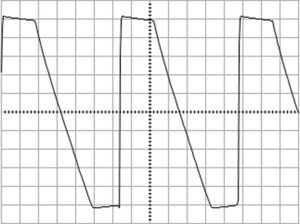
The current A-120 modules have been tuned for several years so that they can be brought to a pleasant-sounding saturation quite early, as is known from the historical models. In principle, this is a symmetrical clipping that cuts off, for example, a sawtooth, triangle or sine at the top and bottom of the oscillation.
Still sounds nice! And compared to the original, I personally think that the possibility of filter distortion goes a lot further due to the tuning of today’s A-120. But owners of original Minimogs can probably say more about this.
User interface
Inputs:
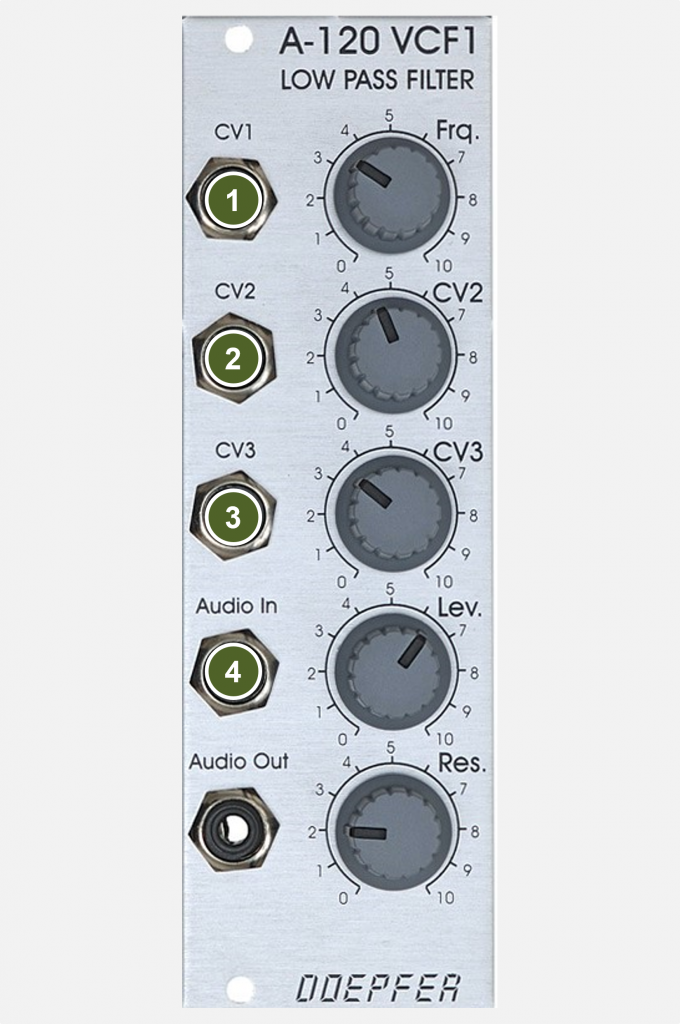
- Frq.: Controller for the cutoff-frequency.
- CV2: Attenuator for the control voltage input “CV2”.
- CV3: Attenuator for the control voltage input “CV3”.
- Lev.: Attenuator for the audio input.
- Res.: Controller for the resonance (self-oscillation) of the filter. Attention: The self-oscillation already starts at a control position of approx. “3”.
Outputs:
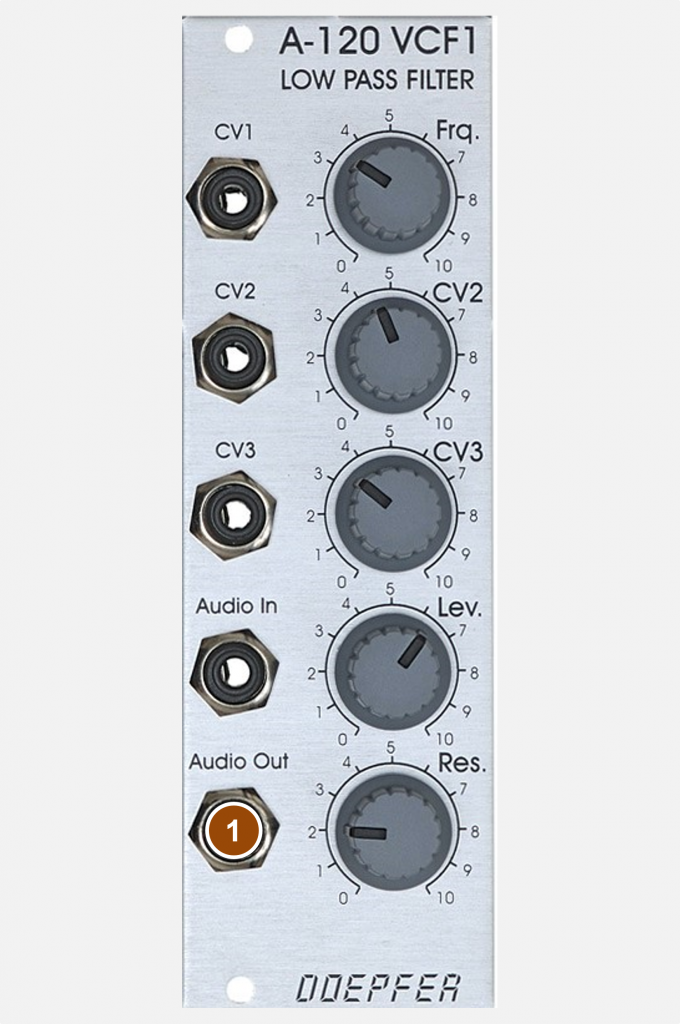
- Audio Out: Output of the filter, here you can hear the filtered input signal.
Controls:
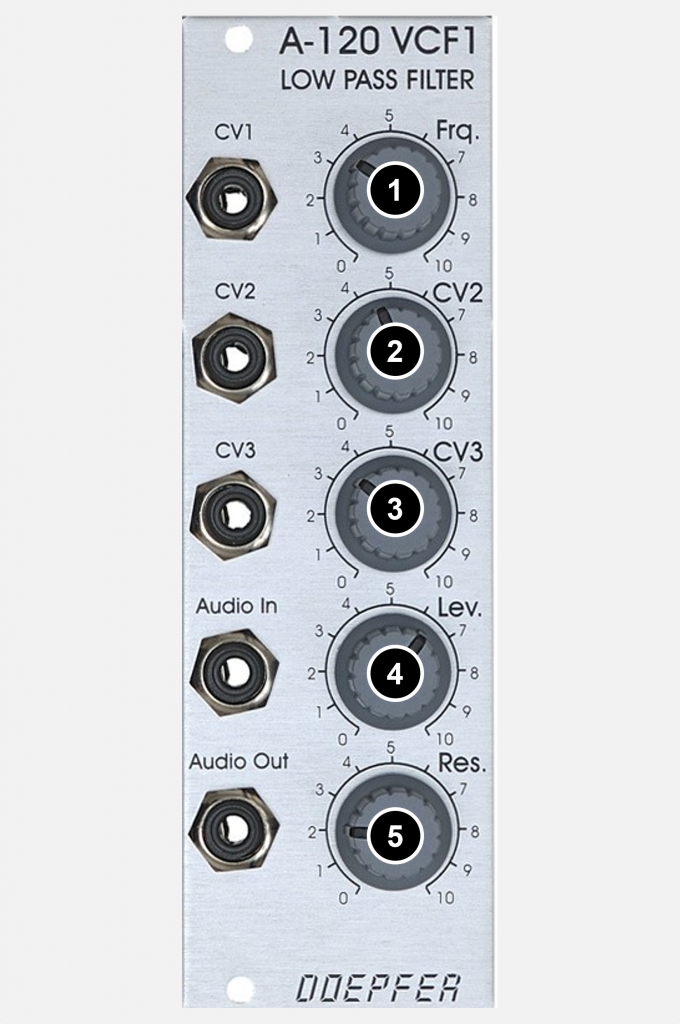
- Frq.: Controller for the cutoff-frequency.
- CV2: Attenuator for the control voltage input “CV2”.
- CV3: Attenuator for the control voltage input “CV3”.
- Lev.: Attenuator for the audio input.
- Res.: Controller for the resonance (self-oscillation) of the filter. Attention: The self-oscillation already starts at a control position of approx. “3”.
Included in basic systems
The A-120 module is part of many basic systems and is therefore comparatively widespread. A very solid filter that sounds good (just not necessarily like “100% original Minimoog in the country where you can see through a millstone”).
For a small system with two inexpensive and classic filters, a combination of this 24dB low-pass filter with the A-106-5 SEM filter (12 dB multimode) is worth considering.
Multiple modulation here too
The “early” Doepfer filters often still have three modulation inputs for the cutoff-frequency. This of course invites you to create more complex modulations with multiple LFOs or envelope generators, without having to sacrifice a mixer for the control voltages.
Alternatives
A-108 48dB Lowpass / Bandpass
Also based on a transistor cascade, but with different slopes (6 dB, 12 dB, 24 dB and 48 dB) as well as a bandpass and direct access to the feedback path: The A-108 filter.
In contrast to the A-120, it not only offers the additional slopes, but also an entry point into the feedback path, with which you can, for example, incorporate a spring reverb etc. into the feedback loop, but which can also be used to implement voltage-controlled feedback with the help of a VCA .
A great tool for variants of classic synthesizer sounds, a total of 6 A-108 filters have been doing their job in my own rack for many years – accompanied, of course, by the “original”, the A-120.
A-103 18dB Lowpass
The A-103 18dB lowpass module offers a differently designed transistor cascade based on the filter of the TB303. It otherwise has the same front panel layout as our A-120 (i.e. 3 control voltage inputs for the cutoff-frequency). Of course, for the true fans of the 303 only a 303 sounds like a 303, for the rest of the world this is an interesting sounding filter module that offers very usable sounds.
A-102 Diode Lowpass
Another classic Doepfer filter module with the same front panel layout and three CV inputs. However, instead of the transistor cascade, diodes are used in the A-102. The model is EMS, the sound and the sound behavior at different corner frequencies / resonances are very unique – and of course worthwhile! (Yes, I have way too many filters in my rack…)
Sound examples
-
A-120 / Filter saturation via input level
As usual I use 3 A-110 VCOs, each with their sawtooth output, mixed in an A-138b and controlled by an A-155 sequencer. VCF and VCA (an A-132-3) are modulated by the same A-140 ADSR, in addition a slow triangle LFO controls the cutoff-frequency of the A-120 filter. I slowly turn the filter resonance from 0 to 10 in each sound sample.
We start with an input level of 1:
Level = 1 In the next examples, the same procedure is followed, the input level is increased each time:
Level = 3 Level = 6 Level = 10
Technical specifications
| Width | 8 HP |
| Depth | 65 mm |
| Power requirements | 30 mA (+12V) / -20 mA (-12V) |

